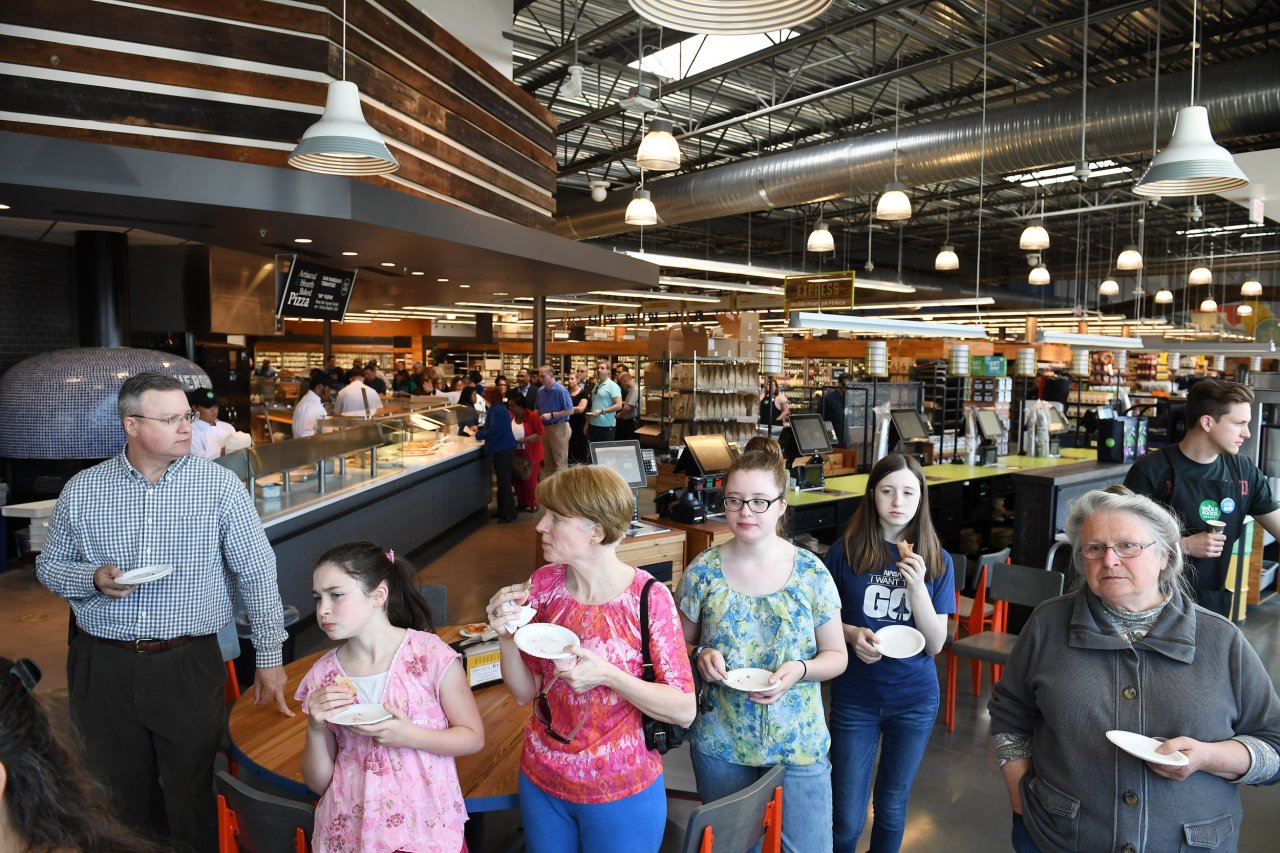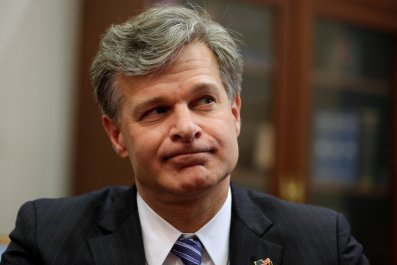Last fall, I walked a mile from downtown New Orleans along an eerily quiet stretch of the Lafitte Greenway to Broad Street. Next to a tire center, a Chinese restaurant, an auto mechanic and a beauty supply store sits one of America's bougiest grocers: Whole Foods. In this neighborhood, on a muggy weekday afternoon, I was sure the place would be deserted; the street is barely on the good side of seedy. But inside, sales were humming. Shoppers of all races and ages rolled their carts up and down aisles stocked with 330 local products. The place felt more like midtown Manhattan than Mid-City New Orleans.
When Whole Foods opens a store like Broad Street, it works, and it's the envy of the industry. But in the past decade, everything from Whole Foods' sales to its legacy have gone to compost. The grocer has gone from being the only natural foods store on the block to taking a beating from just about anybody who sells bananas. Shoppers can find cheaper organics at Trader Joe's, Costco and Kroger. By June, just before the company announced its $13.7 billion sale to Amazon, Whole Foods' stock price had dropped by half in the past four years.
The well-worn explanation: The grocer has been gouging its customers for decades, overcharging for even staple products like dish soap and toilet paper, because it could get away with it by being the best—if not the only—place to buy quality natural food. Then, competitors snuck up on the company, siphoning away its control of the market, diluting its brand and its lofty mission to spread healthy, ethically sourced products across America. Instead, the grocer took on a derisive moniker: "Whole Paycheck."
"People joke about the Whole Paycheck tag, but for 20 or 30 years, it was a reasonable price for organic, natural and unique," says Brian Bolton, a Portland State University finance professor who has studied the company. "That's no longer true. It's hard to identify what the competitive advantage is now. It's not price. It's not selection. It's not location. It's probably not even mission, because customers don't value the mission."
Whole Foods loyalists fear that mission is nearly dead, that Amazon's relentless quest for profit will gobble up the feel-good grocer. But CEO John Mackey sold out to the Nasdaq long before he sold out to Amazon. In taking the company public in 1992, Mackey created unrealistic expectations of growth from short-sighted shareholders and Wall Street analysts. To prop up the company's sagging stock price, he was forced to open too many stores in the wrong locations. Whole Foods wasn't at war with its competitors. It was at war with itself.
Amazon isn't Whole Foods' enemy. It might be the company's savior—if Amazon CEO Jeff Bezos reinvests in its strengths: top-quality products culled from the best supply line in the business. Whole Foods stores remain the most profitable of any grocer in the world, measured in proceeds per square foot. Its successful stores are bright, beautiful and fun to wander through, and there are few other grocers that successfully replicate that experience. If Bezos can refocus Whole Foods on the parts of the company that thrive, the grocer shouldn't have a problem doing battle against its Kroger, Costco and even Trader Joe's rivals.
Since its founding, Whole Foods has largely stuck to a simple, smart formula to determine where to open new stores: Only do it in neighborhoods with a high percentage of college graduates. If you've ever wondered why good grocery stores seem to cluster together, it's because the market research—and the results—demonstrate that it's better to build across the street from a competitor in a well-to-do neighborhood than it is to stick it in the hood. Better to compete with Safeway than with 7-Eleven and McDonald's. A quarter of Whole Foods' stores sit within 5 miles of another Whole Foods store, and 47 percent of them are within 3 miles of a Kroger, which now sells more in organic groceries than anyone else.
Yet in recent years, driven by the inevitable and unreasonable demands for growth in a publicly traded company, Whole Foods has attempted to expand too quickly and in the wrong neighborhoods. Some of the stores haven't work because they are too big, too rushed or poorly designed, in terms of what shoppers in the area might want. And while the store I visited in New Orleans is performing well, that's an exception to the concept of opening stores in neighborhoods with a certain percentage of college graduates and a certain income level, an exception that succeeded only because Broad Street has a smaller footprint, because the building the grocer occupies also houses several related nonprofits and because the location was carefully studied for years before opening, not shoved through to please stockholders. The push for growth ignored these shortcomings too often.
"I think John always regretted going public," says Joe Rogoff, who retired last year as the president of the company's Pacific Northwest region. "I really regretted it. I think Whole Foods and Wall Street were both kind of naïve to think it would be a growth company for its entire life, which seems to be what everything was predicated on."
Another issue: space. Most Whole Foods stores occupy 50,000 square feet. Since the vast majority are leased, that makes each new opening an expensive endeavor that relies on steady customer traffic to survive. With Whole Foods facing increased competition, its traffic nationwide has been lagging: by 3 percent, or 14 million customers annually. Same-store sales fell 2.6 percent last year, the business's worst drop since the Great Recession. If fewer people are coming into your stores, leasing such a gargantuan footprint looks foolish, at least in hindsight.
On balance, though, the stores' profit-per-square-foot slays the competition. Its profit margin is 2.8, well above the industry average 1.7 percent. The obvious pivot, then, is to close its struggling stores, the ones Mackey and his board opened in a race to keep up with unrealistic shareholder expectations. "At the core of Whole Foods is several hundred super-productive stores," says Neil Stern, senior partner at real estate consulting firm McMillanDoolittle. "There are also probably 100 that aren't cutting it, stores built because they're trying to hit some number."
Closing underperforming stores might allow the company to focus on re-energizing its brand. (We've stopped gouging you! Our fair trade–style supply chain is worth paying a few extra bucks!) Yet each of these steps requires a long-term vision and the sacrifice of short-term proceeds. Shareholders want quarterly gains. Mackey was handcuffed because he tried to move a hippie grocery store to Wall Street.
With the Amazon deal, Mackey may have saved himself and his brand. And that's the next best thing to taking it off the stock exchange. "He gets the freedom, but he also gets Daddy Warbucks behind him," Stern says. "Amazon's leverage and backing takes them out of the lens of a public company and under a very large umbrella."
Investors have faith in Bezos's ability to innovate. No company has a more effective distribution model than Amazon, and the Seattle-based retailer is one of the most successful ones on the planet. A short-term hit on Whole Foods' profits driven by closing underperforming stores and lowering prices to be more competitive won't cause a shareholder conniption fit, says Stern, if investors know Whole Foods is relying on Bezos's deep pockets and his reputation. Amazon "wants them to keep doing what they're doing, and have an ability to invent. They need runway," says a source familiar with the Amazon deal. "An example is kind of like what Jeff Bezos did with The Washington Post. These newspapers had such pressure from their ownership to fix leadership, fix classifieds, but they didn't have runway to invent and keep going."
The merger—between a company known for outrageous prices and another known for shrewdly undercutting every competitor on earth—will surely bring some tense moments. Whole Foods has always prided itself on choosing suppliers with the utmost of care and ethical integrity. The entire store is effectively fair trade. That's pretty much the opposite of the Amazon model, which built its success on driving independent bookstores and publishers out of business and is now regularly assailed by sellers of all kinds of products for treating them poorly. "The Amazon culture I'm familiar with is really impersonal and utilitarian. It chews you up and spits you out," Rogoff says. "I hope Bezos allows the culture of Whole Foods to exist."
Getting back to its "roots" was the prescription of several people I interviewed in the past few months. But that prescription was somewhat vague, and with a company like Whole Foods, the formula for a turnaround is complicated. "Before, the response was 'Let's go back to what we're good at, focus on organic and natural,' but there's a lot more competition in this space. This time, they're saying the answer is to act more like a grown-up company: control our costs, lower prices, become more disciplined and centralized," says Stern. "Certainly, those are the right levers to pull for getting costs in line, but what about getting the consumer excited about the brand?"
Therein lies the Whole Paycheck problem. The company is so widely known for overcharging that even if it dropped the price of every item in the store by 20 percent overnight, it's hard to get the word out to customers, who do increasingly care about buying things in a way they can feel good about—to a point. "They reached a tipping point, where the reputation moves from 'I'm paying more for my stuff, and it's worth it' to 'I'm paying more for my stuff, and I'm getting ripped off," Stern says. "Winning that back is not going to be easy. Just because you lower the prices doesn't mean every customer is a human calculator."
Amazon could be a huge help in this department—and improve its own prospects for growth. The company debuted the online grocery shopping service Amazon Fresh seven years ago. It's now in just five markets. Buying Whole Foods indicates that "they intend to get serious about the grocery business," says Stern. "If you're Amazon, and you want to continue to grow, you have to figure out food. It's the largest retail category in the world."
What Amazon will do with its new brick-and-mortar behemoth is unclear. Bloomberg reported in June that Bezos wants to lower prices and replace some cashiers with self-serve checkouts, a notion Amazon spokesman Drew Herdener vehemently denies. (He also says there won't be any layoffs.) Beneath the corporate umbrella of Amazon, Bezos certainly could withstand the short-term cash flow hit that would come from shuttering stores, or he could reorganize them, adding pickup points for Amazon products or simply selling them at Whole Foods. Maybe Amazon becomes the place we order Cheerios in bulk, Whole Foods the place we buy a fresh filet of fish for dinner, and since it's all one company, everybody's happy.
Another smart bet is prepared foods, says Roger Davidson, a former Walmart grocery executive who works as a consultant. Look at Pret a Manger, a U.K.-based food retailer that has recently opened a series of 1,500-square-foot stores in New York, Washington, D.C., Boston and Chicago, in densely population areas. On one side of the narrow space is a refrigerated wall of fresh salads, sandwiches, wraps, soups, yogurt parfaits and healthy beverages, all natural and organic and prepared in-house that morning. At the back of the store is a coffee and pastry bar, and on the right is a seating area. And that's it. No apples, no toilet paper. "We're moving from mass-market processed foods to local, fresh, healthy foods," Davidson says.
To survive in grocery today, a company needs to be strong in one of three areas, Davidson says: price, convenience or "experience fresh." "Aldi, Walmart, Lidl and dollar stores are going to own price. Places like Amazon and Pret a Manger will own convenience. Experience fresh, Whole Foods used to own that, but they've gotten a little lazy and comfortable."
To survive in the cutthroat culture Bezos has created in Seattle, Whole Foods can no longer afford to be either.



















